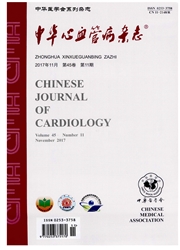

 中文摘要:
中文摘要:
目的探讨血浆同型半胱氨酸水平(Hcy)对急性冠状动脉综合征(ACS)患者经皮冠状动脉介入治疗(PCI)术后发生对比剂肾病(CIN)的影响。方法回顾性分析东南大学附属中大医院2013年1月至2014年12月首次接受PCI的684例ACS患者的临床资料。根据术前血浆Hcy水平,将患者分为高Hcy组(Hcy≥10μmol/L,共404例)和对照组(Hcy〈10μmol/L,共280例)。CIN定义为应用对比剂48~72h内血清肌酐较基础值升高≥44.2μmoL/L,或较基础值升高≥25%。分析两组患者临床基线资料及CIN发生率的差异,并采用多因素logsitic回归分析ACS患者PCI术后发生CIN的危险因素。结果ACS患者PCI术后发生CIN的比例为19.4%(133/684)。高Hcy组发生CIN的比例显著高于对照组[22.0%(89/404)比15.7%(44/280),P=0.040]。多因素logistic回归分析显示,校正年龄、急性心肌梗死、合并症(包括高血压、糖尿病和陈旧性心肌梗死)、实验室检查结果(包括胱抑素C和血尿酸水平)、估算肾小球滤过率、左心室射血分数、冠状动脉三支病变、置入多枚支架和围手术期用药(包括螺内酯和地高辛)后,与对照组比较,高Hcy组发生CIN的风险显著增加(OR=1.70,95%CI1.60~2.64,P=0.021)。结论术前高水平Hcy可能增加ACS患者PCI术后发生CIN的风险。
 英文摘要:
英文摘要:
Objective To explore the impact of plasma homocysteinemia(Hcy) on contrast-induced nephropathy (CIN) after percutaneous coronary intervention (PCI) in acute coronary syndrome (ACS) patients. Methods Consecutive 684 ACS patients undergoing first PCI in our department between January 2013 and December 2014 were prospectively enrolled. Patients were divided into 2 groups according to the pre-procedural plasma Hcy level : high-Hcy group ( Hcy ≥ 10 μ mol/L, n = 404) and control group ( Hcy 〈 10 μmol/L, n = 280). The CIN was defined as serum creatinine ≥ 44. 2 μmol/L or 25% increase compared to baseline within 48 -72 h after PCI. The baseline clinical data and the ratio of CIN were compared between the 2 groups. Multivariate logistic regression analysis was used to define the independent risk factors for CIN. Results CIN occurred in 133 ( 19. 4% ) out of 684 enrolled patients, and the incidence of CIN was significantly higher in high Hcy group than in the control group ( 22. 0% ( 89/404 ) vs. 15.7% ( 44/280 ) , P= 0.040).After adjusting the confounding factors, including age, acute myocardial infarction, co-morbidities (hypertension, diabetes mellitus, and old myocardial infarction), laboratory examination (level of cystatin C and uric acid) , glomerular filtration rate, left ventricular ejection fraction, angiographic and procedural characteristics (3 diseased vessels, muhiple stent implantation), treatment at admission (spironolactone, digoxin), multivariate logistic regression analysis showed that high Hcy was independently associated with the development of CIN (OR=1.70, 95%CI1.60-2.64, P=0.021). Conclusion Elevated Hcy prior PCI is an independent risk factor of CIN in ACS patients undergoing first PCI.
 同期刊论文项目
同期刊论文项目
 同项目期刊论文
同项目期刊论文
 期刊信息
期刊信息
